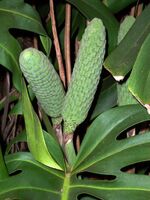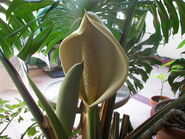| Monstera deliciosa | |
| Classification | |
| Group: | Angiosperms |
|---|---|
| Order: | Arales |
| Family: | Araceae |
| Genus: | Monstera |
| Species: | M. deliciosa |
| Growing | |
| Propagation: | From seeds, cutting, layering |
| Adult size: | over 30 m (90 ft); about 2 m inside |
| Lighting: | Medium |
| Watering: | Let the soil dry slightly before watering |
| Fertilization: | Monthly during active growth |
| Soil: | Well drained |
| Air moisture: | Moist |
| Other information | |
| Toxicity: | Toxic sap; edible fruit (when ripe only) |
Monstera deliciosa (common names: Ceriman, Swiss Cheese Plant, Monstera, Mexican Breadfruit, Delicious Monster and wrongly, Split-leaf philodendron) is a vine of the genus Monstera that originates from Central America. Initially thought to be a Philodendron, it was formerly known as Philodendron pertusum.
Characteristics
Monstera deliciosa is a climbing plant, easily recognizable to its large cut leaves that make it a popular plant. Younger specimens will have full leaves; the cuts begin to appear as the plant gets older, when the conditions are right.
The plant produces long, brown aerial roots it uses in the wild to get a hold on the trees on which it grows in jungles, thus supporting its weak stem that is unable to support its own weight once the plant has more than two or three leaves.
Care
In the nature, M. deliciosa grows by climbing on trees; providing it something to climb on is necessary inside so that the plant can support itself. In a wet enough atmosphere, the plant will readily attach itself to anything it finds; in a normal apartment atmosphere however, it will not, and will have to be manually fixed. Aerial roots that are not actively used by the plant to support itself may be cut.
Fertilization
Light
Good light or shade, keep out of direct sunlight.
Multiplication
The plant can easily be multiplied by cuttings or by layering. It is also possible to sow seeds. The sprouting plantlings will display a phenomenon called negative phototropism; this means that unlike most other plants, they will crawl away from sunlight, toward the darkest place they can find. In the nature, doing so allows them to find the trees they climb on. Once the plantling finds a tree, it will go towards light as expected to grow into the large vine it is known to be.
Pests and diseases
Potting
Washing
To Keep Stoma of leaves clear and open wipe once every 2 weeks with damp sponge.
Watering
Flowering

Unripe fruits
M. deliciosa usually doesn't flower when grown inside. Its flowers are white and similar to those of Spathiphyllum, to which the plant is related. The pollinated flowers give birth to long (approx. 25 cm) green fruit, the ceriman. The fruit is dangerous to eat when unripe, as it is full of oxalic acid, that causes immediate and painful blistering and irritation, swelling, itching, and loss of voice upon ingestion. It takes a full year for the fruit to ripen, at which point it no longer contains oxalic acid and is edible. The fruit has a flesh similar to that of a pineapple, and although delicious, it is not commercialized, because it is difficult to eat; everywhere in the fruit lie the remains of the stamens of the flower, which are long and flat black fibres that need to be removed. The fruit can be used in juices and jelly and is said to taste somewhat like pineapple, banana and pear.
List of cultivars
M. deliciosa 'Variegata': leaves irregularly marked with white and greyish green spots.
Parent species
- M
M
- onstera adansonii
- epipremnoidesMonstera
onstera deliciosa gallery
References
- HODGSON, Larry. 1998. Les Plantes d'Interieur. Broquet. ISBN 2-89000-477-5




